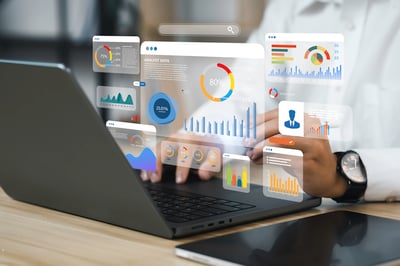January 4, 2024
 by Jasmine Handa / January 4, 2024
by Jasmine Handa / January 4, 2024

Imagine walking into your favorite neighborhood coffee shop.
You take in the aroma of your perfect blend as you are l greeted by a barista who not only knows your name, but remembers your usual order. With a smile, you are invited to enjoy a delicious pastry with a cup of your favorite brew.
At that point, you realize you aren’t just a customer; you’re a precious guest. Now, imagine doing the same with your marketing strategy – personalized welcome, proper interaction, and lasting relationships that go beyond transactions. This is what genuine customer onboarding looks like.
This blog will show you how to turn casual visitors into loyal customers, craft one-on-one personal touches, and build authentic connections through email campaigns.
Onboarding emails are a crucial element of a brand’s communication strategy. They’re specifically structured to guide and engage new users or customers during their initial interactions with a brand’s product, service, or platform. These emails give your customers a personalized introduction and guide them through your brand’s offerings.
Onboarding emails aren’t just for first impressions
Sending onboarding emails is an ongoing process that moves from one welcome email to the next.
They guide users through each step of interacting with a product, service, or platform. While welcome messages matter, the broader goal of onboarding emails is to nurture users, drive engagement, and enhance their experience beyond the initial hello
As an older, easily accessible channel, it helps to develop customer relationships and provides a strategic advantage when it comes to customer onboarding.
Accessibility and reach: Billions of people use email every day. As an original method for onboarding communications, brands must use that reach to maximize audience partnerships.
Personalization and detail: You can tailor emails to individual preferences and behaviors by applying what you learn from data points. This ensures a highly personalized onboarding experience, creating the rapport and value that are critical to effective customer engagement.
Customer onboarding emails offer several benefits for brands that aim to establish strong relationships with new users and customers.
Customer onboarding emails typically begin with a warm welcome, praising the user’s decision to join or use the service.
Marketers go through step-by-step instructions about how to get started, how to navigate the platform, or how to get the most out of the service or product. This leads to a smooth and user-friendly onboarding process.
A customer onboarding email highlights the brand’s best features. They determine how a product or service meets user needs.
By presenting the brand’s identity, values, and unique work to users, onboarding emails create initial engagement with the audience .
These customer onboarding emails first take care of common concerns or questions users have. They help reduce potential barriers to engagement and promote a positive experience.
The impact of customer onboarding emails contributes to overall retention and satisfaction. They set the tone for the customer experience, help reduce churn, lay the foundation for long-term relationships, and forge solid initial connections.
Customer onboarding is a critical process for businesses, and its value cannot be overstated. Keep reading to find out why.
Onboarding is often the first meaningful engagement users get with your product or service. A great onboarding process establishes the tone for the rest of the client relationship and makes a powerful first impression.
Effective onboarding helps customers quickly understand the value of your product or service, which lessens the likelihood of churning. A well-planned onboarding process enhances customer satisfaction, loyalty, and long-term retention.
By speeding up the customer's time to value, onboarding makes it easier for them to quickly see the advantages of working with your brand. Customers are more likely to stay interested and satisfied when they see fast results.
Onboarding empowers customers by teaching them how to use your product correctly. This education makes the user more confident and more likely to continue valuing and using your services.
A thorough onboarding process means customers encounter fewer issues and don’t need as much support. This, in turn, lifts the burden from your customer success team, allowing them to focus on handling more complex queries and strategic responses.
During onboarding, you can introduce customers to additional features or complementary products, providing yourself with opportunities for upselling or cross-selling.
Onboarding is an ideal time to get feedback. Customers are open to sharing, so don’t be shy about asking your new users for their input.
Happy clients will refer you to friends and colleagues.
Onboarding allows you to adapt your approach based on customer feedback. It's an iterative process to ensure your brand is responsive to evolving customer needs.
Consider effective customer onboarding as a strategic investment that pays off in customer satisfaction, loyalty, and success.
Here are some examples of great customer onboarding emails that will help you create better customer relationships.
Introduce your brand, express gratitude for customer trust, and provide guidance about what your clients can expect in the welcome email.
Source: HubSpot.com
Focus on helping users understand your product's features, benefits, and tips for making the most of it. Include tutorials and video guides to give your customers a smooth start.
Source: uplers.com
Encourage users to engage and perform actions on your platform, such as completing their profile, uploading content, or trying a specific feature.
Source: reallygoodemails.com
Include success stories, testimonials, or case studies that demonstrate the value a product or service brings. This builds confidence and shows how their peers have been utilizing the product.
Source: aweber.com
Gather insights early! Ask new users for feedback on their onboarding experience so you can address anything they don’t understand.
Source: Netcore Cloud
For SaaS or subscription-based models, these emails let users know when their trial period is ending so they can continue or end their subscription.
Source: hamaileon.io
If your product has various tiers or features, you can send emails when a user gains access to new capabilities. Highlight how these features can enhance their experience.
Source: Netcore Cloud
Once you think your users are familiar with your work, sales emails like these introduce them to additional products or upgraded plans that align with their buying patterns.
Source: Netcore Cloud
Send interactive emails by adding quizzes or puzzles, forms, or a chatbot to encourage your recipients to engage or ask questions.
Source: Netcore Cloud
Address the user by name, welcome them, and provide a visual walkthrough of your product's key features.
Source: chamaileon.io
You’ve probably often been told that storytelling is the key to effective communication. Craft a sequential email narrative that relates to your brand's mission and values. With each email, the story unfolds, while subtly introducing features and benefits.
Source: emailoctopus.com
You can also turn onboarding into a fun activity by presenting users with a series of challenges or quizzes. Reward them with virtual badges, points, and discounts as they progress through each challenge or quiz.
Source: Netcore Cloud
You can send an AR-powered email that allows users to visualize how your product fits into their real-life environment.
Why not let your users explore the features firsthand before diving in? Send an email with a “try me” button that opens an interactive simulation of your product.
Source: campaignmonitor.com
Encourage subscribers to participate in your brand's community forums, events, and discussions from the very beginning.
Source: bettermode.com
You can guide subscribers through your website's key sections to familiarize them with your blog, product pages, and FAQs.
Source: bettermode.com
These emails know how to multitask. They acknowledge the user, set a positive tone for the start of the relationship, and provide essential information and next steps.
Source: beefree.io
It’s true what they say – strike the hammer when the iron is hot! After sign-up or any initial interaction, you can send emails with embedded useful functionalities. Such emails prove helpful to users, encourage their activity, and bring them towards conversion.
Source: Netcore Cloud
By thoughtfully guiding users through key onboarding steps and resources via well-crafted emails, companies can establish positive initial experiences that set the foundation for lasting partnerships.
An intriguing subject line is all it takes if you want to see an amazing open percentage on your email analytics dashboard.
Try adapting some of these examples of subject lines to fit your specific onboarding context.
Welcome aboard! Your journey with [Your Company Name] starts now 🚀
Unlock the full potential: a guide to getting started with [Your Product/Service]
Your first steps with [Your Product/Service]
Welcome to [Your Company Name]! Here's what to expect in your first week 🌟
Get to know [Your Product]: your personalized onboarding roadmap 🗺️
Meet your [Your Product] family! What you need to know as a new user 👋
Ready, Set, Go! Your essential onboarding checklist for [Your Product/Service]
Congratulations! You're now a part of [Your Company Name]'s community 🎉
You have to tell your customers how happy and excited you are to have them. Make the welcome warm, friendly, and gracious. Briefly explain what users can expect during their onboarding journey.
Talk about yourself, the value they will gain from working with you, and the support they can access.
Make sure your emails reflect your brand's voice and personality because brand consistency offers a sense of familiarity and trust. Invite users to connect on social media, join community forums, or participate in introductory surveys to increase engagement and belonging.
Your email template has to be responsive, meaning it should look good on various devices, especially on mobile. Organize your content with a clear hierarchy. Use headings, subheadings, and visual elements to guide users through the email in a logical and engaging manner.
Incorporate visuals, such as images or graphs, to break up text and make the email visually appealing. Optimize the preview text that users see before opening the email – it should provide a glimpse of the email's content and entice users to open it.
Include customer testimonials or success stories to demonstrate your credibility. Provide in-depth case studies that illustrate how your brand has positively affected businesses or individuals.
Embed links to tutorials, how-to guides, or knowledge base articles within the email.
Clearly communicate the action you want users to take, whether it's exploring a feature, completing a profile, or watching a tutorial. Design your CTA buttons to stand out. Use contrasting colors, captivating copy, and clear messaging to encourage users to click and proceed to the next step.
Limit each email to one primary CTA.
Too many can overwhelm users. Make sure they align with the user's onboarding progress. For example, in the early stages, the CTA might be to set up a profile, while later emails could prompt customers to explore making user-generated content.
By combining these best practices, you create engaging customer onboarding emails that welcome users, guiding them through the onboarding process and setting the stage for a positive and fruitful relationship.
Developing long-term relationships with customers requires techniques that go beyond the basics.
These give you an innovative way to engage with your audience. By incorporating elements like accordions, feedback forms, ratings, or gamification, you create a dynamic experience. This not only captures the user's attention but also encourages them to interact with your brand emails.
Don’t underestimate the power of feedback loops. They are invaluable tools for understanding and meeting the evolving needs and wants of your customers.
This two-way communication optimizes your product or service based on real-time insights, demonstrating your commitment to meeting S expectations.
Surprises always make your customers feel valued. Whether they’re exclusive offers, personalized recommendations, or special acknowledgments, these little treats create positive emotional connections that reinforce customer loyalty.
Once you have set up an automated sequence of emails to onboard customers, you have to identify and analyze essential metrics for evaluating the effectiveness of those emails. This helps you make informed decisions related to your welcome strategy.
The best way to improve the onboarding process is to regularly monitor and analyze these metrics so you’re continuously improving user interactions.
Emails are undoubtedly the best channel for customer onboarding as they give users their own time to understand the best ways to interact with your brand. Customer onboarding emails contribute to reduced churn, enhanced customer satisfaction, and increased retention rates.
Always remember to adhere to best practices, such as clear communication, personalization, and responsive design, to ensure a positive and engaging experience for users.
Moreover, advanced techniques like interactive content and surprise strategies play a crucial role in nurturing long-term relationships. Don’t forget to take advantage of email analytics to continue improving onboarding strategies for sustained customer success.
Ready to elevate Your onboarding experience? Explore our guide for expert insights and tips on crafting a successful customer onboarding process.
Edited by Aisha West
Jasmine Handa is the Assistant Product Marketing Manager at Netcore Cloud. She has close to 4 years of Saas industry experience that encompasses a rich tapestry of expertise, including email marketing, lead generation, webinars, events and podcast, SEO, GTM strategies, and content creation.
You already know customer engagement is more than a buzzword. It’s the difference between...
 by Evelina Milenova
by Evelina Milenova
Stop me if this sounds familiar. You host a party. It comes alive when everyone’s gathered...
 by Dev Iyer
by Dev Iyer
Imagine predicting customers' behavior. This isn’t just a fantasy - it’s reality.
 by Zaid Hashmi
by Zaid Hashmi
You already know customer engagement is more than a buzzword. It’s the difference between...
 by Evelina Milenova
by Evelina Milenova
Stop me if this sounds familiar. You host a party. It comes alive when everyone’s gathered...
 by Dev Iyer
by Dev Iyer


